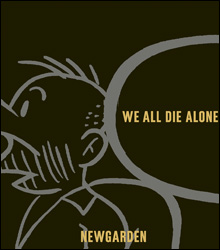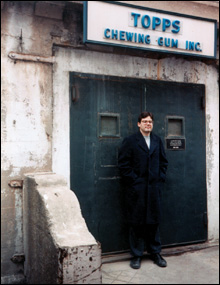 Most of We All Die Alone, which collects Mark Newgarden’s comic art from 1983 to 1994, is concerned with a simple truth: despair and humor come from the same place. This is not a new idea about humor, or about the comic strip. Ernie Bushmiller, who was popular in the ’30s and ’40s, established that it was possible to wring pathos from a cartoon; his legacy includes Chris Ware and the New Yorker’s Bruce Eric Kaplan. But Newgarden was never interested in mainstream graphic art, and his early work, when it was published (much of the material here was culled from the detritus of his scrapbook), appeared mostly in a handful of low-circulation comic-strip ’zines. That alone makes We All Die Alone valuable: it showcases a decade of important art that might otherwise have slipped away.
Most of We All Die Alone, which collects Mark Newgarden’s comic art from 1983 to 1994, is concerned with a simple truth: despair and humor come from the same place. This is not a new idea about humor, or about the comic strip. Ernie Bushmiller, who was popular in the ’30s and ’40s, established that it was possible to wring pathos from a cartoon; his legacy includes Chris Ware and the New Yorker’s Bruce Eric Kaplan. But Newgarden was never interested in mainstream graphic art, and his early work, when it was published (much of the material here was culled from the detritus of his scrapbook), appeared mostly in a handful of low-circulation comic-strip ’zines. That alone makes We All Die Alone valuable: it showcases a decade of important art that might otherwise have slipped away.
In a chronologically scattered introduction, the book’s editor, Dan Nadel, covers the basics. Newgarden was born in 1959 and raised in Brooklyn; in the early ’80s, he was recruited by Art Spiegelman, who was working for Topps Trading Cards, home of bubblegum character Bazooka Joe. Newgarden began work on the company’s Wacky Packages sticker line — a collection of counter-culture satire bundled up with a stick of chewing gum. His innovation was the Garbage Pail Kids, who spoofed the then popular Cabbage Patch Kids.
We All Die Alone makes only fleeting mention of the stickers — I imagine because Newgarden would like to point you toward something more substantial. But the few pages on the Garbage Pail Kids provide useful context. Newgarden turns our preconceptions against us, given that the Garbage Pail Kids are remembered fondly by Gen X and Y millions, you could say those stickers are his biggest success.
He was still a student at the New York’s School of Visual Arts when he began to receive steady work at Topps. By the late ’80s, he had a portfolio that included the Village Voice and National Lampoon and a reputation for pushing the limits of the form. Of his pieces, Pud and Spud is the most challenging, and it’s featured here at length. Newgarden, who drew the strip for RAW magazine and Bad News, seems to have been concerned mostly with making a point. Pud and Spud fractures surreal conversations between the eponymous protagonists into dozens of tiny frames; the result is a herky-jerky read, ultimate meaning rendered irrelevant. In one series of self-reflexive exchanges (ink, blotters, and the act of drawing are part of the discussion and imagery), the pair’s parents die, something they seem to keep forgetting. “You mean those buildings weren’t Dad’s?”, Spud says of their supposed legacy. Pud answers two frames later: “Dad ordered a new shipment of blotters before he burned to death smoking in bed.” What’s funny is also sad and confusing.
 The most unsettling strip here is a series of vignettes titled Love’s Savage Fury. Nadel says that the idea for the piece came from an anonymous personal ad in a 1994 Village Voice. “I saw you on the subway but I forgot what you looked like. I smiled. You ignored me. Send photo.”
The most unsettling strip here is a series of vignettes titled Love’s Savage Fury. Nadel says that the idea for the piece came from an anonymous personal ad in a 1994 Village Voice. “I saw you on the subway but I forgot what you looked like. I smiled. You ignored me. Send photo.”
Newgarden promptly assembled a reply that was featured in RAW. Bazooka Joe sees Ernie Bushmiller’s Nancy on the subway. “I want to see you again. In case I forget what you look like. I rode the same train for three years and I never saw you again. Or maybe I did forget what you looked like.” At this point Newgarden lets Nancy explode into the paper, scattering the geometric shapes of her face across a dozen frames. “And one day it just came back.” We see Joe with a Polaroid camera, taking a picture of her. “I got off quickly, purposely dropping the Polaroid leaving you to wonder why I bothered.”
Nancy goes back to her comic book — True to Life Romances — and Newgarden fills the last frame of the strip with the inky, impenetrable black of the Polaroid shot.